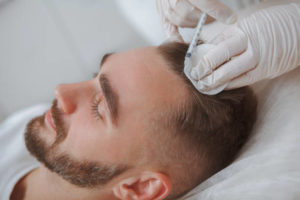 PRP for hair loss is a procedure where a doctor uses a small quantity of your own blood to help restore your hair. It contains growth factors and helpful white blood cells. The procedure is safe and involves no downtime. The doctor will draw blood from your arm and spin it in a specialized centrifuge to separate the plasma and red and white blood cells. This is then injected into the affected area of your scalp. The procedure is painless and can be completed in as little as 30 minutes. Check on prp for hair loss
PRP for hair loss is a procedure where a doctor uses a small quantity of your own blood to help restore your hair. It contains growth factors and helpful white blood cells. The procedure is safe and involves no downtime. The doctor will draw blood from your arm and spin it in a specialized centrifuge to separate the plasma and red and white blood cells. This is then injected into the affected area of your scalp. The procedure is painless and can be completed in as little as 30 minutes. Check on prp for hair loss
To receive PRP for hair loss, you must be healthy and have a clean scalp. Patients undergoing this procedure should avoid sun or excessive heat for at least 24 hours. Patients should also avoid the sun and other types of UV light for a day or two after treatment. However, this therapy does not come without risks.
Because of its potential risks, PRP for hair loss treatment is not appropriate for everyone. It is not a permanent solution and requires several sessions to see results. Patients with medical conditions should discuss their treatment options with their doctor. Many insurance companies consider the treatment to be cosmetic and not medically necessary. Nonetheless, PRP for hair loss can significantly improve the appearance of your hair and can improve your quality of life.
PRP for hair loss is a safe and effective procedure. The procedure involves injecting highly concentrated PRP into the areas of your scalp that need treatment. The procedure may cause some mild pain, but the majority of patients experience minimal or no adverse effects. A week or two after treatment, you may be able to resume your normal activities.
The primary blood component is platelets, which are responsible for stimulating tissue growth and healing. After platelet-rich plasma is injected into hair follicles, it stimulates the production of stem cells and growth factors that are important for hair growth. The concentration of these cells is approximately five times higher in PRP than in normal blood.
Depending on your specific condition, PRP treatments for hair loss may require more than one session. Most patients need three sessions, separated by one month, to achieve maximum results. However, you can receive PRP treatments every three to six months to maintain results. It is best to consult with your medical provider about the exact schedule and frequency of treatments.
Aside from PRP treatments, dermatologists may recommend other medical treatments in conjunction with PRP treatments for hair loss. Some patients will experience bruising at the injection site, but this should dissipate within a few days. It is important to note that this procedure is safe and will produce long-term results.
The procedure itself is relatively painless and requires little preparation. Typically, a topical numbing cream is applied to the scalp before the procedure to minimize discomfort. The doctor will then take a small sample of the patient’s blood. The blood is then spun in a special PRP extracting tube. After the PRP solution is extracted, a small amount of PRP is injected into the scalp. The total treatment time can last up to 90 minutes.
The procedure is a three-step procedure that includes drawing blood, processing, and injection. Injection of platelet-rich plasma into the scalp is an excellent option for patients who experience significant hair loss. The procedure is performed by a facial plastic surgeon who has advanced knowledge of underlying diseases and the most current therapies. The procedure does not require invasive surgery and has minimal downtime.
A PRP therapy usually takes no longer than an hour. The doctor will first draw blood from the arm, then place the platelets in a centrifuge. This will separate the fluids of different densities and then extract the platelets with a syringe. Next, a small amount of platelet-rich plasma will be drawn up in a syringe and injected into the areas of the scalp where hair loss is occurring. PRP therapy is not a permanent solution, but it can stimulate new hair growth in the follicles.
